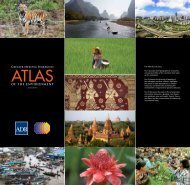ETEE7
ETEE7
ETEE7
Create successful ePaper yourself
Turn your PDF publications into a flip-book with our unique Google optimized e-Paper software.
48 Symposium on Combating Wildlife Crime<br />
PLENARY SESSION 3<br />
National Policy and Legal Frameworks<br />
to Curb the Wildlife Trade<br />
Ms. Patricia Moore, international legal expert and former head of the International Union for<br />
Conservation of Nature’s (IUCN) Regional Environmental Law Programme Asia Division and Ecosystems<br />
and Livelihoods Group Asia Division, recalled that during the first session that morning, the participants<br />
heard about how governments need good laws, but many countries have confusing wildlife laws and weak<br />
penalties. Ms. Moore said that this need not be the case because the CITES CoP gave clear instructions<br />
on what member countries should have in their legislation to comply with CITES. She then asked the<br />
participants to consider the problems resulting from weak penalties and loopholes in national wildlife laws<br />
that traffickers could exploit, and to think of ways of strengthening national legislation.<br />
Mr. John T. Webb, retired assistant chief of the Environmental Crimes Section of the US Department<br />
of Justice, gave an overview of how wildlife traffickers are prosecuted in the US. He wanted the<br />
participants to realize that the process of strengthening a country’s wildlife prosecution system takes time<br />
and reminded them that law enforcement entails not just guidance but also punishment and deterrence.<br />
Mr. Webb then walked the participants through the development of the Environmental Crimes Section<br />
of the US Department of Justice, which considers the prosecution of international wildlife traffickers a<br />
very serious matter. In 1978, then US President James Earl “Jimmy” Carter, Jr., an avid supporter of CITES<br />
(also known as the Washington Convention) noted the growing trade in CITES-protected species and<br />
the sophistication of the traffickers. President Carter therefore directed the US Department of Justice to<br />
create within the department a special unit to prosecute illegal wildlife trade cases. The unit was called the<br />
Wildlife and Marine Resources Section and later renamed the Environmental Crimes Section. About 40<br />
prosecutors are engaged in the international prosecution of wildlife trafficking criminals, while another 100<br />
federal prosecutors handle a part-time or full-time load of wildlife cases.<br />
To ensure the effective enforcement of CITES, the US government itself complies with CITES and<br />
punishes its citizens who violate the convention. However, a CITES violation in the US is penalized only as<br />
a misdemeanor, which may merit imprisonment of 1 year or a fine of $100,000. The US government also<br />
recognizes the complexity of wildlife laws and other environmental statutes, so it directs the prosecution<br />
of wildlife cases based on white-collar crime. To ensure that wildlife cases and other environmental crimes<br />
are treated seriously and are worthy of the time of the investigator, the prosecutor, and the court, the US<br />
Department of Justice focuses its time and resources on developing expertise not only in investigating<br />
wildlife cases but also in presenting them in court.<br />
The US Department of Justice also uses the full array of US criminal justice statutes. For instance, in<br />
prosecuting wildlife importers, instead of simply applying the pertinent wildlife statute, which carries only<br />
a 1-year imprisonment sentence, the department applies the Langley Statute, among others, to impose<br />
stiffer penalties. The Langley Statute penalizes the importation of merchandise in violation of another law<br />
with 20 years’ imprisonment. The department also uses the anti–money laundering statute to seize the<br />
proceeds of an illegal activity.<br />
To end, Mr. Webb said that the Environmental Crimes Section of the US law enforcement system<br />
follows a set of sentencing guidelines or sentencing criteria to determine which cases to prosecute based





